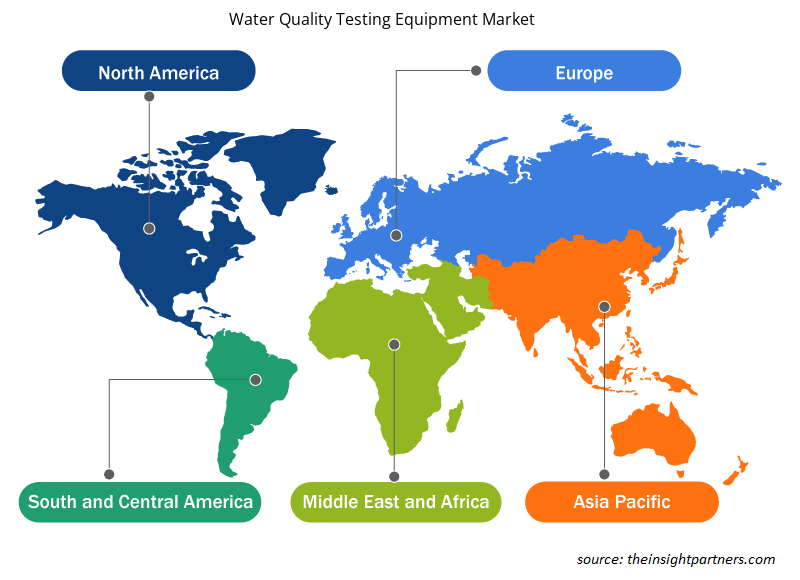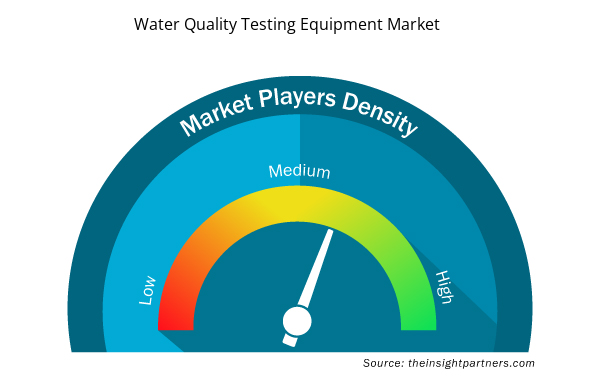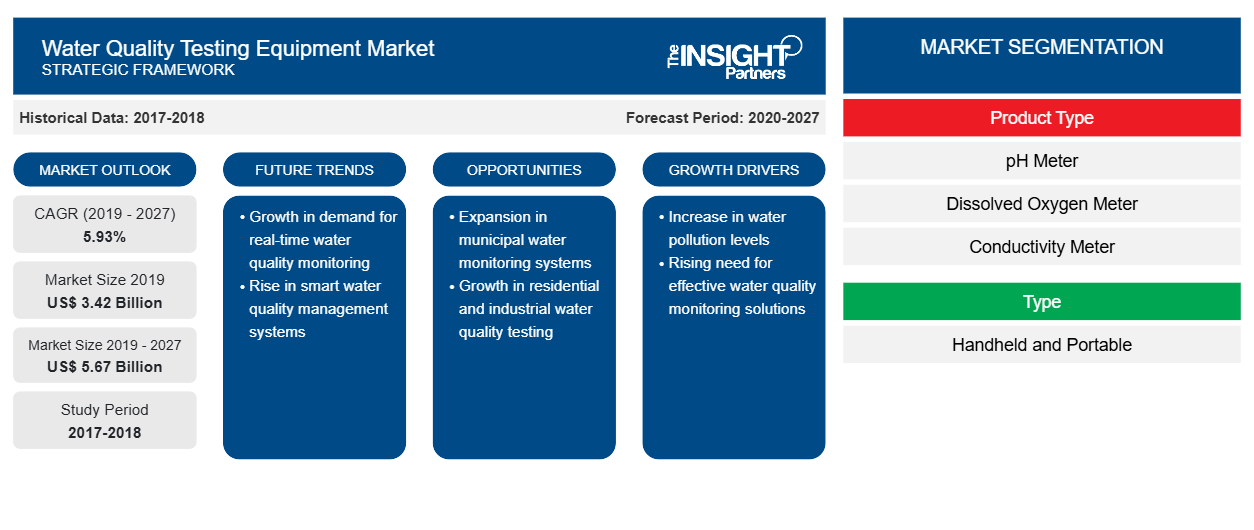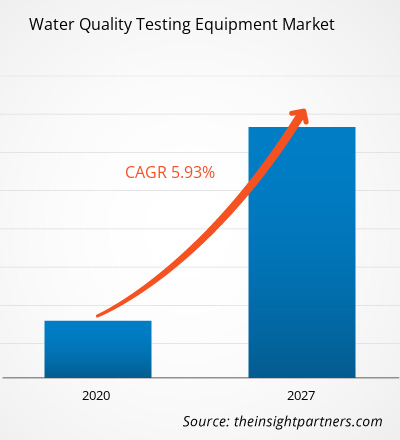Nel 2018, il mercato delle apparecchiature per il test della qualità dell'acqua ha rappresentato 3,42 miliardi di dollari USA e si prevede che crescerà a un CAGR del 5,93% nel periodo di previsione 2019-2027, fino a raggiungere i 5,67 miliardi di dollari USA entro il 2027.
Il Nord America è stato il mercato geografico leader e si prevede che sarà il maggiore contributore di entrate per tutto il periodo di previsione. Si prevede che investimenti significativi nel settore delle infrastrutture idriche da parte del governo nelle nazioni sviluppate degli Stati Uniti e del Canada alimenteranno il mercato delle apparecchiature per i test della qualità dell'acqua in questa regione.
Approfondimenti di mercato
Rigorose legislazioni in tutto il mondo sul mantenimento della qualità dell'acqua per contribuire alla crescita del mercato delle apparecchiature per il test della qualità dell'acqua
Il Clean Water Act (CWA) negli Stati Uniti è responsabile della protezione dei corpi idrici negli Stati Uniti con gli standard stabiliti in base all'uso desiderato. Il Safe Drinking Water Act (SWDA) nel paese è responsabile del mantenimento e del miglioramento della qualità dell'acqua potabile fornita alle masse. Lo SWDA è anche responsabile dell'elenco degli standard negli impianti di trattamento delle acque pubbliche.
Personalizza questo report in base alle tue esigenze
Riceverai la personalizzazione gratuita di qualsiasi report, comprese parti di questo report, o analisi a livello nazionale, pacchetto dati Excel, oltre a usufruire di grandi offerte e sconti per start-up e università
- Scopri le principali tendenze di mercato in questo rapporto.Questo campione GRATUITO includerà analisi di dati che spaziano dalle tendenze di mercato alle stime e alle previsioni.
Tecniche innovative di elaborazione dell'acqua per guidare la crescita complessiva del mercato delle apparecchiature di prova della qualità dell'acqua
Il processo di desalinizzazione dell'acqua è un processo ampiamente adottato nei paesi del Medio Oriente per portare un equilibrio tra domanda e offerta di acqua. Tuttavia, si osserva che il processo ha impatti negativi specifici sui corpi idrici e sull'ecosistema idrico correlato. È stato notato che il processo di desalinizzazione determina la diffusione di sostanze chimiche e agenti anti-fouling nel mare. Come misura correttiva, le agenzie idriche utilizzano stazioni di allerta automatiche e molte altre apparecchiature di test della qualità dell'acqua per monitorare la qualità dell'acqua. Si prevede pertanto che le adozioni di sistemi di monitoraggio della qualità dell'acqua aumenteranno nella regione del Medio Oriente.
Informazioni sul tipo di prodotto
Il mercato globale delle apparecchiature per il test della qualità dell'acqua per tipo di prodotto è stato guidato dal segmento del misuratore di pH. Gli altri sistemi per il mercato delle apparecchiature per il test della qualità dell'acqua includono sensori di temperatura, sensori di misurazione della silice, misurazione del sodio, misurazione del ferro e sensori di carbonio organico totale (TOC), tra gli altri. Il tester di torbidità ha detenuto il secondo mercato più grande nel 2017 e si prevede che perderà le sue quote durante il periodo di previsione dal 2019 al 2027.
Tipo Informazioni
Il mercato globale delle apparecchiature per il test della qualità dell'acqua per tipo è stato guidato dal segmento da banco. Con la crescente concentrazione verso la ricerca e lo sviluppo dell'analisi della qualità dell'acqua da parte del governo e per la ricerca accademica, la domanda di apparecchiature da banco principalmente per scopi di laboratorio sta aumentando significativamente la richiesta di apparecchiature da banco per la qualità dell'acqua.
Informazioni per l'utente finale
Il mercato globale delle apparecchiature per il test della qualità dell'acqua è segmentato in base all'utente finale come apparecchiature per test portatili/portatili e da banco. I settori commerciali hanno detenuto il secondo mercato più grande nel 2017 e si prevede che continueranno a detenere le loro quote durante il periodo di previsione dal 2019 al 2027. L'altro utente finale del mercato delle apparecchiature per il test della qualità dell'acqua include i settori dell'istruzione, delle scienze della vita e di altre scienze naturali.
Gli attori del mercato presenti nel mercato delle apparecchiature per il test della qualità dell'acqua si concentrano principalmente sui miglioramenti dei prodotti implementando tecnologie avanzate. Firmando partnership, contratti, joint venture, finanziamenti e inaugurando nuovi uffici in tutto il mondo, l'azienda può mantenere il suo marchio a livello globale. Di seguito sono elencati alcuni degli sviluppi recenti;
2019: Emerson ha annunciato l'introduzione di una nuova tecnologia di sensori per fornire una stabilità del sensore circa dieci volte maggiore e ridurre il rischio in termini di qualità e resa per i produttori biofarmaceutici.
2017: AquaPhoenix ha annunciato una nuova app di test mobile denominata "Aliquot", principalmente per i tecnici dell'acqua per rendere i loro test quotidiani semplici ed efficienti. Questa applicazione è disponibile per dispositivi mobili iOS e Android.
2017: Shimadzu ha annunciato un centro di innovazione di ricerca e sviluppo congiunto a Singapore. Questo centro è composto da 7 membri dello staff che lavorano per lo sviluppo di un sensore ambientale ad alta sensibilità per rilevare azoto e fosforo contenuti in laghi e fiumi.
Approfondimenti regionali sul mercato delle apparecchiature per il test della qualità dell'acqua
Le tendenze regionali e i fattori che influenzano il mercato delle apparecchiature per test di qualità dell'acqua durante il periodo di previsione sono stati ampiamente spiegati dagli analisti di Insight Partners. Questa sezione discute anche i segmenti di mercato delle apparecchiature per test di qualità dell'acqua e la geografia in Nord America, Europa, Asia Pacifico, Medio Oriente e Africa e Sud e Centro America.

- Ottieni i dati specifici regionali per il mercato delle apparecchiature per il test della qualità dell'acqua
Ambito del rapporto di mercato sulle apparecchiature per il test della qualità dell'acqua
| Attributo del report | Dettagli |
|---|---|
| Dimensioni del mercato nel 2019 | 3,42 miliardi di dollari USA |
| Dimensioni del mercato entro il 2027 | 5,67 miliardi di dollari USA |
| CAGR globale (2019 - 2027) | 5,93% |
| Dati storici | 2017-2018 |
| Periodo di previsione | 2020-2027 |
| Segmenti coperti | Per tipo di prodotto
|
| Regioni e Paesi coperti | America del Nord
|
| Leader di mercato e profili aziendali chiave |
|
Densità degli attori del mercato delle apparecchiature per il test della qualità dell'acqua: comprendere il suo impatto sulle dinamiche aziendali
Il mercato delle apparecchiature per test di qualità dell'acqua sta crescendo rapidamente, spinto dalla crescente domanda degli utenti finali dovuta a fattori quali l'evoluzione delle preferenze dei consumatori, i progressi tecnologici e una maggiore consapevolezza dei vantaggi del prodotto. Con l'aumento della domanda, le aziende stanno ampliando le loro offerte, innovando per soddisfare le esigenze dei consumatori e capitalizzando sulle tendenze emergenti, il che alimenta ulteriormente la crescita del mercato.
La densità degli operatori di mercato si riferisce alla distribuzione di aziende o società che operano in un particolare mercato o settore. Indica quanti concorrenti (operatori di mercato) sono presenti in un dato spazio di mercato in relazione alle sue dimensioni o al valore di mercato totale.
Le principali aziende che operano nel mercato delle apparecchiature per il test della qualità dell'acqua sono:
- ABB Ltd
- Agilent Technologies Inc.
- AquaPhoenix Scientific Inc.
- Società Danaher,
- Azienda Emerson Electric
Disclaimer : le aziende elencate sopra non sono classificate secondo un ordine particolare.

- Ottieni la panoramica dei principali attori del mercato delle apparecchiature per il test della qualità dell'acqua
ATTREZZATURE PER TESTARE LA QUALITÀ DELL’ACQUA GLOBALE – SEGMENTAZIONE DEL MERCATO
Per tipo di prodotto
- Misuratore di pH
- Misuratore di ossigeno disciolto
- Misuratore di conduttività
- Misuratore di torbidità
- Altri
Per tipo
- Portatile/ palmare
- Da banco
Per utente finale
- Industriale
- Commerciale
- Governo
- Altri
Per Geografia
America del Nord
- NOI
- Canada
- Messico
Europa
- Francia
- Germania
- Regno Unito
- Russia
- Italia
- Resto d'Europa
Asia Pacifico (APAC)
- Australia
- Cina
- India
- Giappone
- Corea del Sud
- Resto dell'APAC
Medio Oriente e Africa (MEA)
- Arabia Saudita
- Sudafrica
- Emirati Arabi Uniti
- Resto del MEA
America del Sud (SAM)
- Brasile
- Argentina
- Resto del SAM
Profili aziendali
- ABB Ltd
- Agilent Technologies Inc.
- AquaPhoenix Scientific Inc.
- Società Danaher,
- Azienda Emerson Electric
- Eurofins Scientific SE
- Elettrica generale (GE)
- Azienda
- Società Shimadzu
- Termo-Fisher Scientifico
- Analisi storica (2 anni), anno base, previsione (7 anni) con CAGR
- Analisi PEST e SWOT
- Valore/volume delle dimensioni del mercato - Globale, regionale, nazionale
- Industria e panorama competitivo
- Set di dati Excel


- Dairy Flavors Market
- Procedure Trays Market
- Biopharmaceutical Contract Manufacturing Market
- Space Situational Awareness (SSA) Market
- Retinal Imaging Devices Market
- Adaptive Traffic Control System Market
- Neurovascular Devices Market
- Energy Recovery Ventilator Market
- Pipe Relining Market
- Hydrogen Storage Alloys Market

Report Coverage
Revenue forecast, Company Analysis, Industry landscape, Growth factors, and Trends

Segment Covered
This text is related
to segments covered.

Regional Scope
North America, Europe, Asia Pacific, Middle East & Africa, South & Central America

Country Scope
This text is related
to country scope.
Trends and growth analysis reports related to Electronics and Semiconductor : READ MORE..
The List of Companies - Water Quality Testing Equipment Market
- ABB Ltd
- Agilent Technologies Inc.
- AquaPhoenix Scientific Inc.
- Danaher Corporation,
- Emerson Electric Co.
- Eurofins Scientific SE
- General Electric (GE)
- Horiba, Ltd.
- Shimadzu Corporation
- Thermo-Fisher Scientific
The Insight Partners performs research in 4 major stages: Data Collection & Secondary Research, Primary Research, Data Analysis and Data Triangulation & Final Review.
- Data Collection and Secondary Research:
As a market research and consulting firm operating from a decade, we have published and advised several client across the globe. First step for any study will start with an assessment of currently available data and insights from existing reports. Further, historical and current market information is collected from Investor Presentations, Annual Reports, SEC Filings, etc., and other information related to company’s performance and market positioning are gathered from Paid Databases (Factiva, Hoovers, and Reuters) and various other publications available in public domain.
Several associations trade associates, technical forums, institutes, societies and organization are accessed to gain technical as well as market related insights through their publications such as research papers, blogs and press releases related to the studies are referred to get cues about the market. Further, white papers, journals, magazines, and other news articles published in last 3 years are scrutinized and analyzed to understand the current market trends.
- Primary Research:
The primarily interview analysis comprise of data obtained from industry participants interview and answers to survey questions gathered by in-house primary team.
For primary research, interviews are conducted with industry experts/CEOs/Marketing Managers/VPs/Subject Matter Experts from both demand and supply side to get a 360-degree view of the market. The primary team conducts several interviews based on the complexity of the markets to understand the various market trends and dynamics which makes research more credible and precise.
A typical research interview fulfils the following functions:
- Provides first-hand information on the market size, market trends, growth trends, competitive landscape, and outlook
- Validates and strengthens in-house secondary research findings
- Develops the analysis team’s expertise and market understanding
Primary research involves email interactions and telephone interviews for each market, category, segment, and sub-segment across geographies. The participants who typically take part in such a process include, but are not limited to:
- Industry participants: VPs, business development managers, market intelligence managers and national sales managers
- Outside experts: Valuation experts, research analysts and key opinion leaders specializing in the electronics and semiconductor industry.
Below is the breakup of our primary respondents by company, designation, and region:

Once we receive the confirmation from primary research sources or primary respondents, we finalize the base year market estimation and forecast the data as per the macroeconomic and microeconomic factors assessed during data collection.
- Data Analysis:
Once data is validated through both secondary as well as primary respondents, we finalize the market estimations by hypothesis formulation and factor analysis at regional and country level.
- Macro-Economic Factor Analysis:
We analyse macroeconomic indicators such the gross domestic product (GDP), increase in the demand for goods and services across industries, technological advancement, regional economic growth, governmental policies, the influence of COVID-19, PEST analysis, and other aspects. This analysis aids in setting benchmarks for various nations/regions and approximating market splits. Additionally, the general trend of the aforementioned components aid in determining the market's development possibilities.
- Country Level Data:
Various factors that are especially aligned to the country are taken into account to determine the market size for a certain area and country, including the presence of vendors, such as headquarters and offices, the country's GDP, demand patterns, and industry growth. To comprehend the market dynamics for the nation, a number of growth variables, inhibitors, application areas, and current market trends are researched. The aforementioned elements aid in determining the country's overall market's growth potential.
- Company Profile:
The “Table of Contents” is formulated by listing and analyzing more than 25 - 30 companies operating in the market ecosystem across geographies. However, we profile only 10 companies as a standard practice in our syndicate reports. These 10 companies comprise leading, emerging, and regional players. Nonetheless, our analysis is not restricted to the 10 listed companies, we also analyze other companies present in the market to develop a holistic view and understand the prevailing trends. The “Company Profiles” section in the report covers key facts, business description, products & services, financial information, SWOT analysis, and key developments. The financial information presented is extracted from the annual reports and official documents of the publicly listed companies. Upon collecting the information for the sections of respective companies, we verify them via various primary sources and then compile the data in respective company profiles. The company level information helps us in deriving the base number as well as in forecasting the market size.
- Developing Base Number:
Aggregation of sales statistics (2020-2022) and macro-economic factor, and other secondary and primary research insights are utilized to arrive at base number and related market shares for 2022. The data gaps are identified in this step and relevant market data is analyzed, collected from paid primary interviews or databases. On finalizing the base year market size, forecasts are developed on the basis of macro-economic, industry and market growth factors and company level analysis.
- Data Triangulation and Final Review:
The market findings and base year market size calculations are validated from supply as well as demand side. Demand side validations are based on macro-economic factor analysis and benchmarks for respective regions and countries. In case of supply side validations, revenues of major companies are estimated (in case not available) based on industry benchmark, approximate number of employees, product portfolio, and primary interviews revenues are gathered. Further revenue from target product/service segment is assessed to avoid overshooting of market statistics. In case of heavy deviations between supply and demand side values, all thes steps are repeated to achieve synchronization.
We follow an iterative model, wherein we share our research findings with Subject Matter Experts (SME’s) and Key Opinion Leaders (KOLs) until consensus view of the market is not formulated – this model negates any drastic deviation in the opinions of experts. Only validated and universally acceptable research findings are quoted in our reports.
We have important check points that we use to validate our research findings – which we call – data triangulation, where we validate the information, we generate from secondary sources with primary interviews and then we re-validate with our internal data bases and Subject matter experts. This comprehensive model enables us to deliver high quality, reliable data in shortest possible time.


 Ottieni un campione gratuito per questo repot
Ottieni un campione gratuito per questo repot